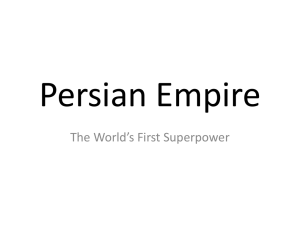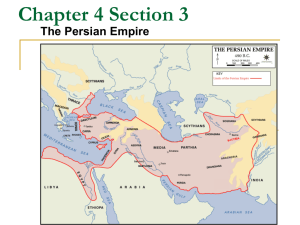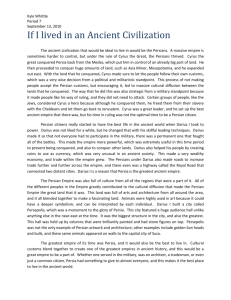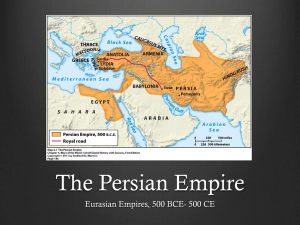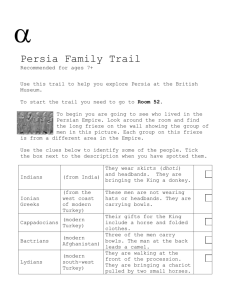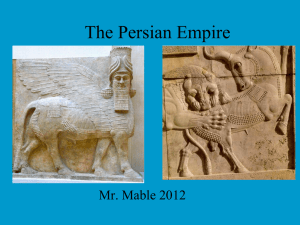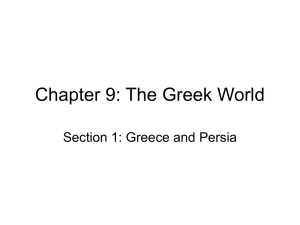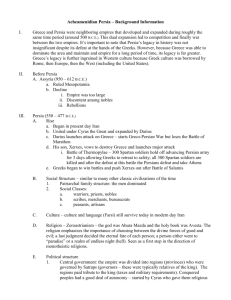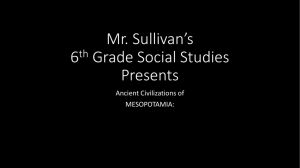Persian Empire - Dsapresents.org
advertisement
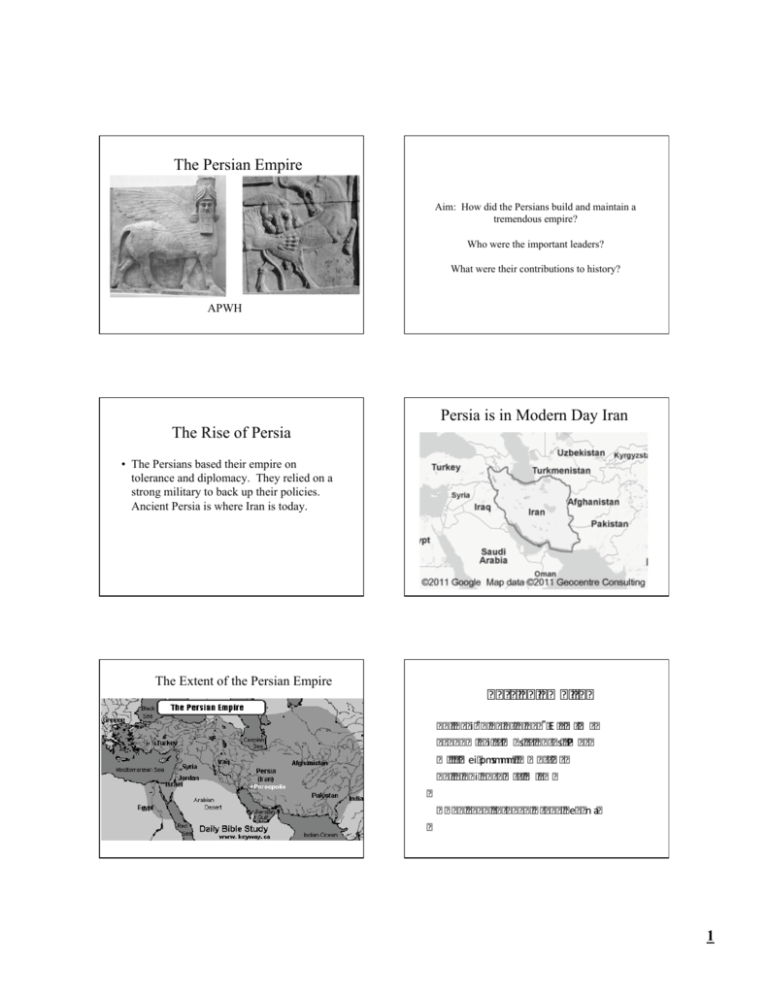
The Persian Empire Aim: How did the Persians build and maintain a tremendous empire? Who were the important leaders? What were their contributions to history? APWH Persia is in Modern Day Iran The Rise of Persia • The Persians based their empire on tolerance and diplomacy. They relied on a strong military to back up their policies. Ancient Persia is where Iran is today. The Extent of the Persian Empire i i s ei pmsmmm i E s P e na 1 Cyrus (559-530 BC) Cambyses (530-525 BC) Darius (521-486 BC) Xerxes (486-465 BC) Cyrus the Great Cyrus’s Empire • 550 BC – Conquered several neighboring kingdoms • Military genius • Controlled an empire spanning 2000 miles • Kindness toward conquered people • Honored local customs and religions • 538 BC - Allowed the Jews to return to their homeland, Jerusalem • Considered by the Jews to be one of God’s anointed ones Primary Source • “This is the word of Cyrus king of Persia: The Lord, God of heaven has given me all the kingdoms of the earth, and he himself has charged me to build him a house at Jerusalem in Judah. To every man of his people now among you I say, God be with him, and let him go up to Jerusalem in Judah, and rebuild the house of the Lord God of Israel, the God whose city is Jerusalem.” • What type of ruler was Cyrus based on this quote? 2 PERSIA and the city of PERSEPOLIS PERSEPOLIS PERSEPOLIS VOCABULARY WORDS • At the height of the Persian Empire it stretched from India to Africa • Persia today is known as Iran • The city included extensive use of columns • 518 BCE • King Darius utilized influences and materials from all over his empire, which included Babylon, Egypt, Mesopotamian and Greece • The COLUMN is divided into three parts: • The BASE • The SHAFT • The CAPITAL • This shaft is FLUTED PERSEPOLIS • Dauris was followed by his son, Xerxes (ruled 485-465) • The Apadana (Audience Hall) features wonderful low relief sculpture Persian Art Persepolis, Iran • Apadana with huge columns 60 feet tall • 36 columns with bull-shaped tops • Reliefs on walls symbolize Persian guards called Immortals • 10,000 Immortals protected the city and ruler • Large ramps leading to apadana enable chariots to enter hall 18 3 Z-what? What is it? So what did he say? • Zoroaster had a simple message: • Zoroastrianism is the First Monotheistic religion in the world – Good Thoughts, Good Words, and Good Deeds • Below: Raphael's 1509 painting of The School of Athens . – In it, Zoroaster and Ptolemy are having a discussion. The prophet is holding a star-studded globe. • Name given to followers of Prophet Zoroaster/Zarathushtra • State religion of the Kings of Persia • Cyrus the Great: – Conquered lands from Afghanistan to Egypt – – Ruled justly, – First Bill of Human Rights • King Darius: – Universal currency/coins (Dariks), – First postal system • Predominant from 1000 BC – 1000 CE Zoroastrian-ism: History Tenets of Zoroastrian-ism Good Thoughts, Good Words, and Good Deeds One God: The Amesha Spenta or the attributes of Ahura Mazda (God) 1. Asha is Righteousness. God is Righteous therefore He is Just and morally perfect. 2. Vohu Mano is the Good Mind. God has the perfect mind and therefore he is incapable of choosing anything evil. 3. Spenta Aramaity is Benevolence. God is benevolent and loves and trusts his creation to eventually become perfect as he has wanted it to be from the moment he created it. 4. Kshathra Vairya is the power to do Good. God uses his power to do only Good. 5. Houravatat is Perfection. God is Perfect. 6. Ameretat is Immortality. God is Immortal. Our Role: Human beings are expected to develop these virtues. They must: Learn what Righteousness is, and choose the right path. Be benevolent (good to others), and trust that God has intended them to be good. Evil is within people- (like being selfish). If all human beings choose to use their power to do only good and fight evil, then the rule of reason will prevail. How did Cyrus and Darius keep control of such a vast empire? Popular Parsi Zoroastrian depiction. This image emerged in the 18th century • Founded in ~1000 BCE – Mazdaism – since Ahura Mazda is the Divine Creator • State religion of Mede, Achemenian, Parthian, and Sassanian Rulers • The Persians (Achaemenid Empire) were conquered by Alexander the Great of Greece in 330 BCE – Alexander was influenced by Xenophon s book – The Training of Cyrus the Great • In 670 CE, the Persian Sassanid dynasty was overthrown by Arabs armies – Many Persians were killed, others converted to Islam, some remained in Iran – but a few escaped…and fled to India 22 Satraps • Broke Empire down into provinces • Royal Governors = Satraps • They were loyal to the Emperor and did his bidding. 4 Royal Spies Persian Empire, 500 BC • They spied on the citizens and on the governors to make sure they were not going to steal or revolt. The Royal Road • 1,677 miles long with 111 relay stations • Other smaller roads branched off the royal road • Relay stations had rest areas and fresh horses. • The entire royal road could be traveled in a week by a horsemen • Caravans took about a month How would the royal road enable a ruler to maintain power in the empire? Darius 5 Darius the Great • Member of the king’s body guard • Overthrew the king in 522 BC • Took power and created a well-organized efficient government • Brought peace and stability • Expanded the empire by 500 miles • But could not conquer Greece First Persian War Battle of Marathon Marathon part 1 The Athenians had won at Marathon but they certainly had not destroyed the Persian army. They had made plans before the battle that if they won, they would get word back to Athens as soon as possible because they knew that the Persian fleet was sure to sail around Attica and attempt to take the city while it was undefended. The citizens were to man the walls and make it appear that Athens was strongly defended. Marathon Marathon part 2 Phaedippas Miltiades sent a young soldier (probably Phaedippas) to take word back to Athens. He ran the entire distance, 42.192 kms, shouted "We have won!" and fell dead of exhaustion. In memory of this event the Marathon Run was included among the contests since the first contemporary Olympic Games. 6 Result of the 1st Persian War Xerxes • Became a Dictator Darius Lost! Persia Continued to lose its power to expand Second Persian War • Did not follow Darius or Cyrus and was not tolerant • Wanted to conquer Greece at all cost Battle of Thermopylae • It means the “HOT GATES” • 300 Spartans held off 1 million troops of the Persian Empire • Was really a delaying action to stall the Persians so that Athens could be evacuated. • Tactical advantage because of choke point in the terrain. Thermopylae 7 The Immortals • Xerxes’s best troops in the Persian army. • Supposed to be invincible. • Spartans proved othewise. The Persians eventually Broke Through Greek Trireme • After killing the 300 Spartans the Persians Marched on Athens • Athens was deserted; evacuated to the Island of Salamis • The Athenians forced a naval battle in the Bay of Salamis Battle of Salamis Battle of Salamis • Persians were bottlenecked in the small bay of Salamis • They could not maneuver • The smaller Greek Ships destroyed the Persian fleet. 8 Result of the 2nd Persian War Alexander the Great Xerxes Lost! • Macedonian (Greek) King that laid the final death blow to the Persian Empire and conquered it. Persia had to retreat home in failure. Never again did Persia expand. Where is Greece? Where is Macedonia? Greece? In November 333, Alexander the Great and his trusted general Parmenion defeated the Persian king Darius III Codomannus on the uneven coastal plain south of Issus. 9
